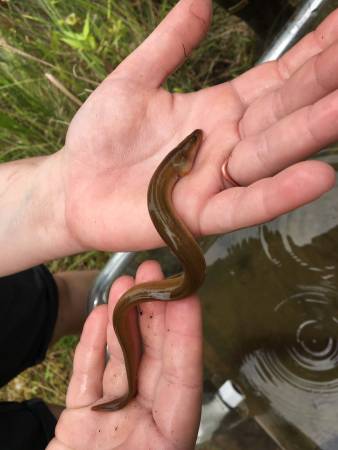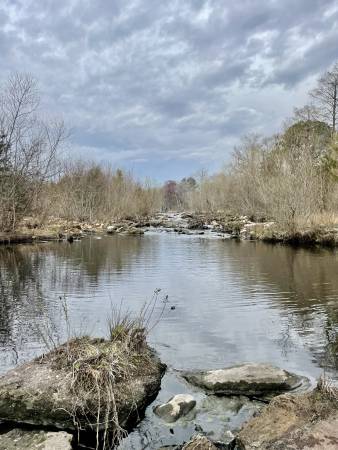
The slippery slimy snake-like creature that dwells at the bottom of our watershed is none other than the American Eel. The American Eel is a member of the fish family with a long back fin that runs halfway down their back. Mature eels vary in color from dark green and brown on the top to greenish-yellow to white on their bellies. The American Eel historically has been found all over the East Coast of the North American Continent, ranging from Mexico all the way up to Canada. They are found in the dark burrows and masses of plants along the bottom of bodies of water. They hunt primarily at night and hide during the day. With their keen sense of smell, eels hide in mud, sand, and gravel waiting to surprise crustaceans, aquatic insects, and anything else they can swallow.
Eels have a unique feature by being catadromous (ka-ta-dro-mus). This is a scientific term for the unique mating cycle for American Eels. They travel thousands of miles, leaving their freshwater homes to migrate to the ocean to spawn, after they spawn they die in the ocean. The baby eels return to the freshwater habitats that their parents came from. Until recently, the American Eel’s life cycles and mating habits were unknown. It wasn’t until scientists followed these slithery swimmers did they find out that eels made their way out to the Atlantic Ocean and finally to the Sargasso Sea. After spawning, the eggs stay in the Sargasso Sea until they hatch. The early stage eels, called glass eels, make their way back to their homes in the freshwater rivers of North America until they mature and begin the cycle all over again.

But these resilient wanderers are being confronted with challenges. In fact, the American Eel is labeled as endangered on the International Union for Conservation of Nature’s (IUCN) list of endangered species. Because their life cycle is so complex, American Eels face a wide range of threats. Due to overfishing and the construction of hydroelectric dams, their numbers have plummeted. Commercial fishing of eels have contributed to their decline, but the major obstacle to healthy populations are the hydroelectric dams blocking their migration. Eels are meant to overcome obstacles like waterfalls with their mucus-covered snake-like bodies, but a dam is too much for any eel. Not only are dams an obstacle, but they reduce the amount of oxygen in the water. American Eels are highly sensitive to low oxygen levels, in combination with the blocking of their migration patterns, eels are at high risk for extinction in the wild.

Often misunderstood, the American Eel is as much a part of our biological community as the more charismatic Blue Crab or flounder. They bring mussels upstream who, in turn, clean the water, making it healthier for fish like the eel. Local groups, like the Maryland Coastal Bays Program, are taking steps to reduce these threats, such as the Bishopville Fish Passageway project which was completed in 2015. Through a partnership with the Maryland Department of Natural Resources, St. Martins Neck Homeowners Association, US Fish and Wildlife Service, Biohabitats, and Underwood and Associates. This successful project is part of the way that restoration can redress the harm of environmental degradation.

